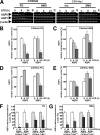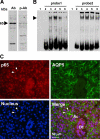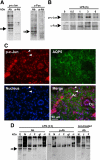Potential down-regulation of salivary gland AQP5 by LPS via cross-coupling of NF-kappaB and p-c-Jun/c-Fos
- PMID: 20522648
- PMCID: PMC2913374
- DOI: 10.2353/ajpath.2010.090282
Potential down-regulation of salivary gland AQP5 by LPS via cross-coupling of NF-kappaB and p-c-Jun/c-Fos
Abstract
The mRNA and protein levels of aquaporin (AQP)5 in the parotid gland were found to be potentially decreased by lipopolysaccharide (LPS) in vivo in C3H/HeN mice, but only weakly in C3H/HeJ, a TLR4 mutant mouse strain. In the LPS-injected mice, pilocarpine-stimulated saliva production was reduced by more than 50%. In a tissue culture system, the LPS-induced decrease in the AQP5 mRNA level was blocked completely by pyrrolidine dithiocarbamate, MG132, tyrphostin AG126, SP600125, and partially by SB203580, which are inhibitors for IkappaB kinase, 26S proteasome, ERK1/2, JNK, and p38 MAPK, respectively. In contrast, the expression of AQP1 mRNA was down-regulated by LPS and such down-regulation was blocked only by SP600125. The transcription factors NF-kappaB (p65 subunit), p-c-Jun, and c-Fos were increased by LPS given in vivo, whereas the protein-binding activities of the parotid gland extract toward the sequences for NF-kappaB but not AP-1-responsive elements present at the promoter region of the AQP5 gene were increased by LPS injection. Co-immunoprecipitation by using antibody columns suggested the physical association of the three transcription factors. These results suggest that LPS-induced potential down-regulation of expression of AQP5 mRNA in the parotid gland is mediated via a complex(es) of these two classes of transcription factors, NF-kappaB and p-c-Jun/c-Fos.
Figures







Similar articles
-
Epigallocatechin gallate stimulates the neuroreactive salivary secretomotor system in autoimmune sialadenitis of MRL-Fas(lpr) mice via activation of cAMP-dependent protein kinase A and inactivation of nuclear factor κB.Autoimmunity. 2015;48(6):379-88. doi: 10.3109/08916934.2015.1030617. Autoimmunity. 2015. PMID: 25847253
-
Dexamethasone inhibits IL-12p40 production in lipopolysaccharide-stimulated human monocytic cells by down-regulating the activity of c-Jun N-terminal kinase, the activation protein-1, and NF-kappa B transcription factors.J Immunol. 2004 Jan 1;172(1):318-30. doi: 10.4049/jimmunol.172.1.318. J Immunol. 2004. PMID: 14688340
-
Limited role of ceramide in lipopolysaccharide-mediated mitogen-activated protein kinase activation, transcription factor induction, and cytokine release.J Biol Chem. 1999 Apr 2;274(14):9342-50. doi: 10.1074/jbc.274.14.9342. J Biol Chem. 1999. PMID: 10092612
-
Dynamics of Salivary Gland AQP5 under Normal and Pathologic Conditions.Int J Mol Sci. 2020 Feb 11;21(4):1182. doi: 10.3390/ijms21041182. Int J Mol Sci. 2020. PMID: 32053992 Free PMC article. Review.
-
Physiological role of aquaporin 5 in salivary glands.Pflugers Arch. 2016 Apr;468(4):519-39. doi: 10.1007/s00424-015-1749-6. Epub 2015 Nov 5. Pflugers Arch. 2016. PMID: 26537593 Review.
Cited by
-
Down-regulation of aquaporin3 expression by lipopolysaccharide via p38/c-Jun N-terminal kinase signalling pathway in HT-29 human colon epithelial cells.World J Gastroenterol. 2015 Apr 21;21(15):4547-54. doi: 10.3748/wjg.v21.i15.4547. World J Gastroenterol. 2015. PMID: 25914463 Free PMC article.
-
Aquaporins in Glandular Secretion.Adv Exp Med Biol. 2023;1398:225-249. doi: 10.1007/978-981-19-7415-1_16. Adv Exp Med Biol. 2023. PMID: 36717498
-
Experimental Animal Model Systems for Understanding Salivary Secretory Disorders.Int J Mol Sci. 2020 Nov 10;21(22):8423. doi: 10.3390/ijms21228423. Int J Mol Sci. 2020. PMID: 33182571 Free PMC article. Review.
-
Aqp5 is a new transcriptional target of Dot1a and a regulator of Aqp2.PLoS One. 2013;8(1):e53342. doi: 10.1371/journal.pone.0053342. Epub 2013 Jan 10. PLoS One. 2013. PMID: 23326416 Free PMC article.
-
Effects of downregulation of aquaporin1 by peptidoglycan and lipopolysaccharide via MAPK pathways in MeT-5A cells.Lung. 2011 Aug;189(4):331-40. doi: 10.1007/s00408-011-9288-1. Epub 2011 Jun 4. Lung. 2011. PMID: 21647617
References
-
- Yakata K, Hiroaki Y, Ishibashi K, Sohara E, Sasaki S, Mitsuoka K, Fujiyoshi Y. Aquaporin-11 containing a divergent NPA motif has normal water channel activity. Biochim Biophys Acta. 2007;1768:688–693. - PubMed
-
- Itoh A, Tsujikawa T, Fujiyama Y, Bamba T. Enhancement of aquaporin-3 by vasoactive intestinal polypeptide in a human colonic epithelial cell line. J Gastroenterol Hepatol. 2003;18:203–210. - PubMed
-
- Verkman AS. Physiological importance of aquaporins: lessons from knockout mice. Curr Opin Nephrol Hypertens. 2000;9:517–522. - PubMed
-
- Marinelli RA, Tietz PS, Pham LD, Rueckert L, Agre P, LaRusso NF. Secretin induces the apical insertion of aquaporin-1 water channels in rat cholangiocytes. Am J Physiol Gastrointest Liver Physiol. 1999;276:G280–G286. - PubMed
-
- Steinfeld S, Cogan E, King LS, Agre P, Kiss R, Delporte C. Abnormal distribution of aquaporin-5 water channel protein in salivary glands from Sjögren’s syndrome patients. Lab Invest. 2001;81:143–148. - PubMed
Publication types
MeSH terms
Substances
LinkOut - more resources
Full Text Sources
Molecular Biology Databases
Research Materials
Miscellaneous

